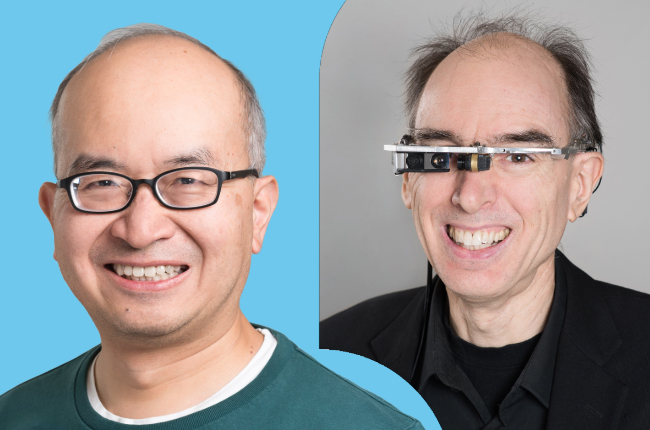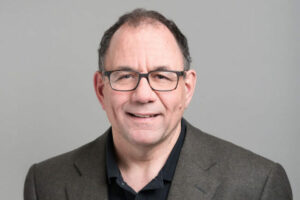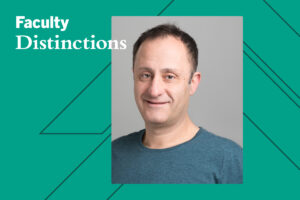
JANUARY 18, 2024 • By Matthew Tierney
ECE professors Hoi-Kwong Lo and Steve Mann have been named IEEE Fellows for 2024 — the highest grade of membership, given to those whose accomplishments in engineering, science and technology have shown significant value to society.
IEEE is the world’s largest technical professional organization, a leading authority in areas ranging from computers and telecommunications to biomedical engineering, electric power and consumer electronics.
Lo, who was named “for contributions to the theory and practice of quantum cryptography,” says that the quantum research field has grown exponentially since he switched his field to quantum computing in 1994.
“Back then, all the papers I needed to read before doing research could fit in a single physical folder, and I could spend months on a paper, to understand it deeply. Now hundreds of new papers appear every day!”
Today, quantum cryptography is our most secure method to protect information and is used by large commercial entities and governments. Among Lo’s notable achievements is his proof that one of the best-known applications of quantum cryptography, called quantum key distribution (QKD), has virtually unbreakable encryption, or is “information-theoretically secure.”
Over the years, his career has struck a balance between theory and practice. He was the first to perform a successful quantum hack of the photon detectors in early commercial QKD systems, which helped improve the technology. And he demonstrated with ECE professor Li Qian a more efficient and distance effective protocol of QKD, called “decoy state,” now a standard technique in the field.
A few years ago, he co-founded the start-up Quantum Bridge to design and build quantum-safe security solutions.
Lo, with an undergraduate degree in math and graduate degrees in theoretical particle physics, is happy for the recognition for research contributions to engineering from IEEE and its community.
“To develop quantum science into technologies, it is important to consider real-life constraints and imperfections, which is an engineer’s strength,” he says. “These real-life constraints should be regarded as opportunities, in the same way that real-life constraints of quantum phenomena inspire new research directions.”
Professor Steve Mann was named “for contributions to wearable and immersive computing technologies” — an apt citation for someone who is widely regarded as “the father of wearable computing.”
In the 1970s, he coined the terms “metavision” and “metaveillance” to refer to the sensing of sensors and the sensing of their capacity to sense. Metavision is regarded by many as the predecessor of the metaverse. This work led Mann, together with Charles Wyckoff at MIT, to invent and coin the terms “eXtended Reality” (XR) and “eXtended Intelligence” (XI) in 1991.
For decades, Mann used computer-mediated vision systems that he invented, which he wore as a head-mounted display in his everyday life. In 2012, he co-founded Meta together with Meron Gribetz, Ben Sand, and his student, Raymond Lo, to introduce these eyeglass products to the world: the Meta, Meta-Pro, and Meta-2 AR (Augmented Reality).
This is just one of his many inventions over the years, emerging from research that focuses on the intersections between humans, technology and nature.
He also invented the “hydraulophone,” the world’s first musical instrument whose sounds result from vibrations in liquids. The instrument opened the door the new field of integral kinematics and mechanics based on “absement,” his term to refer to the time-integral of displacement.
Many of his other inventions occurred in the field of digital imaging: for example, he invented High Dynamic Range (HDR), which combines multiple differently-exposed pictures of the same subject matter. He used this technology to develop a seeing aid called “EyeTap,” as well as a computational welding helmet. HDR is now used in nearly every commercially manufactured camera, including nearly every smartphone.
Lately, Mann has pivoted from the term “augmented reality” for philosophical reasons.
“An ‘augmented’ reality, as I see it, uses technology that can disconnect you from your environment — it can distance you from it,” says Mann. “I believe we need technology to interpolate between all the realities, the physical environment as well as the social, or ‘invironment,’ and the virtual, or ‘vironment.’”
This idea has taken full flight with Mann’s new initiative, called “Mersivity,” which held its first symposium late last year.
“The ideas raised in this symposium remind us of the vital importance of harnessing technology in the service of people and planet,” said University of Toronto President Meric Gertler in his welcoming remarks, underscoring how the University has made sustainability a priority issue to address.
“Mersivity is a design ethos, a guiding set of ideas to promote tech that’s in symbiosis with our surrounding environment — not just sensing or recording it, but engaging and giving back,” Mann says. “Its goal is technology that’s for Earth and everyone, including other species.”
“Professors Lo and Mann are seen as pioneers in their respective fields, with distinguished careers that are internationally renowned," says Professor Deepa Kundur, Chair of ECE. “Their election as Fellows reflects the significant role they play within the worldwide engineering research and development community. Congratulations, Hoi-Kwong and Steve!”


